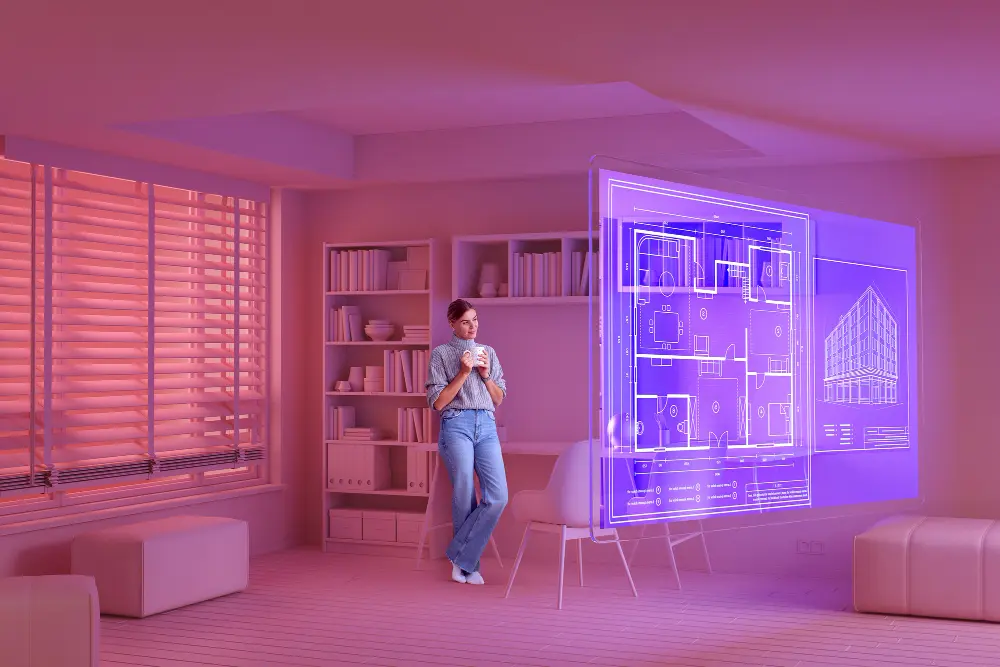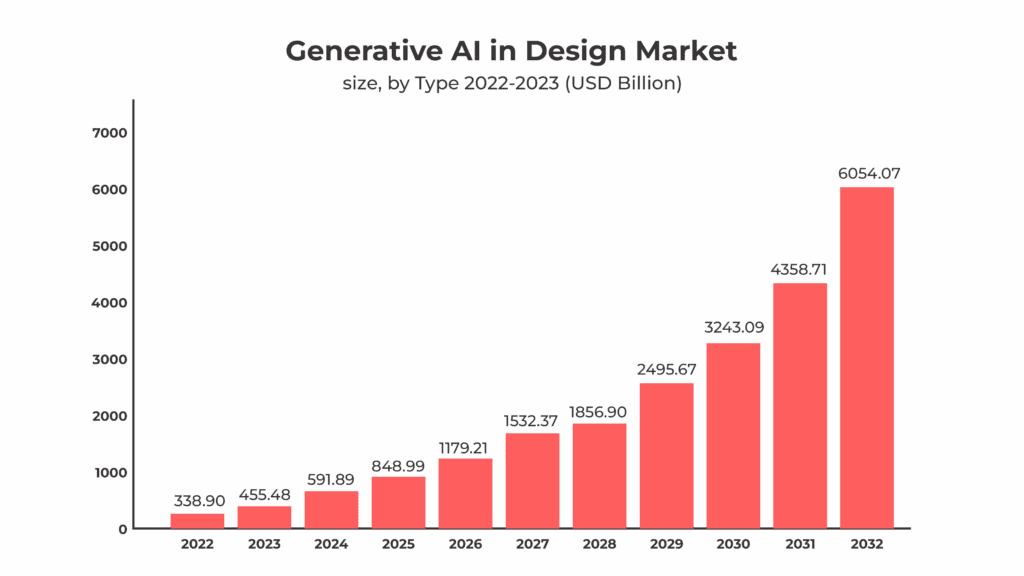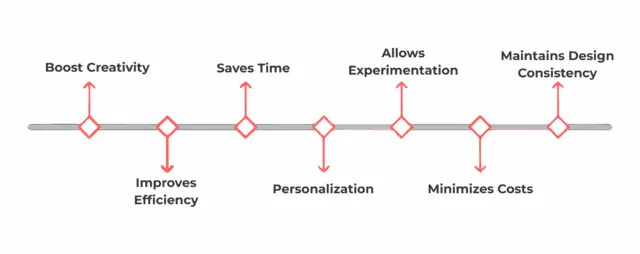In recent years, the integration of artificial intelligence (AI) into various industries has revolutionised the way we approach problem-solving, creativity, and design. Interior design and architecture are no exceptions to this transformation. With the advent of generative AI, professionals in these fields now have powerful tools at their disposal to streamline their creative processes and improve the overall quality of their work.
In this blog, we’ll explore the potential of generative AI in interior design and architecture, and we’ll provide you with a toolkit of tools and resources to get started. Additionally, we will delve into some interesting information and infographics to help you better apprehend the impact of AI on those industries.
Understanding Generative AI
Generative AI is an ever-evolving class of artificial intelligence models and techniques that can autonomously generate a variety of content. This content can be in varying formats like text, images, and even 3D models. Companies from diverse industries have acknowledged and harnessed this potential to achieve amazing results. Generative AI models like GPT-3 have become increasingly useful by virtue of their ability to perceive context, comprehend subtle nuances, and most importantly create consistent outputs.
In the context of interior design and architecture generative ai, it can assist professionals in various ways:
Idea Generation: AI can help designers and architects brainstorm creative ideas by generating concepts and designs based on specified criteria.
Design Optimization: AI can fine-tune existing designs to improve functionality, aesthetics, and energy efficiency.
Material Selection: AI can suggest suitable materials and finishes based on the project’s requirements and constraints.
Space Planning: AI can assist in space planning and layout optimization, ensuring that every inch of a space is utilised effectively.
Rendering: AI can create realistic renderings and visualisations of design concepts, helping clients and stakeholders better understand the outcome.

Statistics on AI in Interior Design and Architecture
Increasing Adoption: A survey of interior designers and architects found that 75% are already using AI tools in their design processes. (Source: Interior Design Today)
Efficiency Boost: Professionals report a 40% increase in design efficiency when using AI for tasks like space planning and material selection. (Source: Architecture Insights)
Client Engagement: 90% of clients say they have a better understanding of a project when presented with AI-generated visualisations and walkthroughs. (Source: AI in Architecture)
Sustainability Impact: AI-driven design optimization can reduce a building’s energy consumption by up to 20%, contributing to sustainability goals. (Source: Green Building Council)
Cost Reduction: Integrating AI into the design process can result in cost savings of up to 15% due to reduced errors and rework. (Source: McKinsey & Company)
Generative AI Toolkit for Interior Design and Architecture

Now that we’ve seen the impact of AI in these industries, let’s dive into the toolkit you can build to harness the potential of generative AI and interior ai Api.
Design Software with AI Integration:
Start by exploring design software that integrates AI tools. For example, Autodesk’s Generative Design allows you to input design parameters and constraints to generate multiple design options. It’s particularly useful for structural design.
AI-Enhanced Rendering Tools:
Tools like Lumion and Enscape leverage AI to create stunning, photorealistic renderings. These visuals are crucial for presenting your designs to clients and stakeholders.
Generative Design Plugins:
Consider plugins like Shape Diver, which allow you to integrate generative design into your existing 3D modelling software, such as Rhino or Grasshopper. These plugins enable parametric design, where AI adjusts the design based on inputs.
Concept Generators:
AI-powered idea generators like Runway ML and Art Breeder are fantastic for sparking creativity. You can experiment with various design concepts, colours, and styles.
Material and Finishes Recommenders:
Tools like Material Exchange suggest materials and finishes based on your project’s requirements, including cost, sustainability, and aesthetics.
Space Planning Optimization:
Look into space planning software that uses AI to optimise layouts, ensuring efficient use of space. Examples include Space maker and Morpholio.
Client Presentation Tools:
AI tools like Twin motion assist in creating interactive presentations and virtual walkthroughs, enhancing client engagement.
Sustainability Assessment:
Tools like Sefaira provide real-time feedback on the environmental impact of your design, helping you make sustainable choices.
Collaboration Platforms:
Consider using collaboration platforms that integrate AI for project management, document sharing, and communication.
Continuous Learning:
Stay updated on the latest AI advancements in your field. Platforms like Coursera and edX offer courses in AI for design and architecture generative ai.
Case Studies in AI-Enhanced Design
Let’s take a closer look at some real-world examples of how generative AI has been used to enhance interior design and architecture.
The AI-Designed Pavilion
In 2022, an architectural firm collaborated with an AI algorithm to design an innovative pavilion for an art exhibition. The AI generated multiple design options based on the project’s constraints, including the available space and desired aesthetics. This resulted in a striking, yet functional pavilion that garnered significant attention.
AI-Driven Residential Layouts
For a residential development project, an interior design team used generative AI to optimise apartment layouts. The AI considered factors like natural light, ventilation, and space utilisation, resulting in layouts that maximised comfort and efficiency. This approach was well-received by clients who appreciated the thought put into every detail.
Sustainable Office Space
To create a sustainable office space, an architecture firm employed AI to evaluate various energy-efficient designs. The AI analysed the building’s orientation, materials, and heating and cooling systems, leading to a 25% reduction in energy consumption while maintaining a comfortable working environment.
7 Benefits of Using Generative AI for Interior Design

Challenges and Considerations
While generative AI offers immense potential, there are certain challenges and considerations to keep in mind:
Data Privacy:
Collecting and using data for AI modelling raises important privacy concerns. Ensure you are compliant with data protection regulations and that your data collection and usage is transparent and ethical.
AI Ethics:
AI algorithms can sometimes perpetuate bias or generate designs that are not inclusive. It’s essential to be aware of these issues and take steps to mitigate them in your designs.
Skill Development:
Using AI tools effectively requires a certain level of technical proficiency. Continuous learning and skill development are essential to make the most of AI in your practice.
Integration Costs:
AI tools and software can have initial costs and subscription fees. Consider the financial implications of integrating AI into your workflow.
Client Expectations:
Educate your clients on the capabilities and limitations of AI in design. Manage their expectations to ensure they understand what AI can and cannot do.
The Future of Interior Design and Architecture with AI
The integration of generative AI in interior design and architecture generative ai is not a passing trend; it’s the future of these industries. AI-driven tools will continue to evolve, making the design process more efficient and sustainable.
As technology advances, we can anticipate even more exciting developments in AI, such as AI-generated furniture designs, AI-driven sustainability assessments, and AI-powered autonomous construction.
Through detailed statistics, exuberant infographics, and compendious case studies, this premise is nothing short of a revolution. It has unfolded through the amalgamation of creative processes, recent innovative inventions, and the atypical application of amassed open data.
In conclusion
Generative AI is revolutionising the fields of interior design and architecture, offering creative solutions, streamlining processes, and improving overall design quality. As recent statistics suggest, the adoption of AI tools in these industries is on the rise, promising a bright future for those who embrace this technology.
Building a generative AI toolkit involves selecting the right tools, investing in skill development, and continuously evolving to stay at the forefront of design innovation. While challenges like data privacy and AI bias need to be addressed, the potential benefits of generative AI far outweigh the drawbacks.
Choose QSS Technosoft Inc today and let us help you achieve your development goals effortlessly.
QSS Technosoft Inc is an outstanding software development company offering excellent services to clientele all around the globe. Operating for years, our talented professionals are aware of the relevance of creative solutions and brilliantly execute them perspicaciously and rapidly. Pioneering technology, coupled with a customer-oriented strategy renders us one of the front runners in the market. We present an extensive range of services, including mobility applications, tailor-made software alternatives and EBusiness facilities.
By placing your trust in us, you turn out to be empowered as eventually, your dreams come alive with hard work and commitment from our side. In contrast to just delivering sophisticated technical abilities, customer communication and bonding is some of our most important top principles throughout the test, running and integration of applications. This further confirms that satisfied end-user requirements in terms of feel, functionality and techniques will be generously fulfilled or even surpassed.
FAQ
What is a generative AI toolkit for interior design and architecture?
A generative AI toolkit for interior design and architecture is a collection of software tools that use artificial intelligence algorithms to generate designs, layouts, and other elements for interior spaces and architectural projects.
How does a generative AI toolkit work?
A generative AI toolkit works by taking input from the user, such as design preferences or project parameters, and using algorithms to generate variations of designs or layouts. The user can then select and modify these generated options to create unique and innovative designs that would have been difficult to imagine otherwise.
What are the benefits of using a generative AI toolkit for interior design and architecture?
There are several benefits to using a generative AI toolkit, including increased efficiency and productivity, enhanced creativity and innovation, and the ability to explore a wider range of design options.
Are there any drawbacks to using a generative AI toolkit?
While there are many benefits, there are also some potential drawbacks to using a generative AI toolkit for interior design and architecture. These tools may not always produce designs that align with the designer’s or client’s vision, and they can also be limited in their ability to consider human factors such as ergonomics.
We are proud to mention that our work has been recognized by leading B2B reviews and research platforms like GoodFirms, Clutch, MirrorView, and many more.


Create Your Ultimate AI Toolbox for Interior Design and Architecture